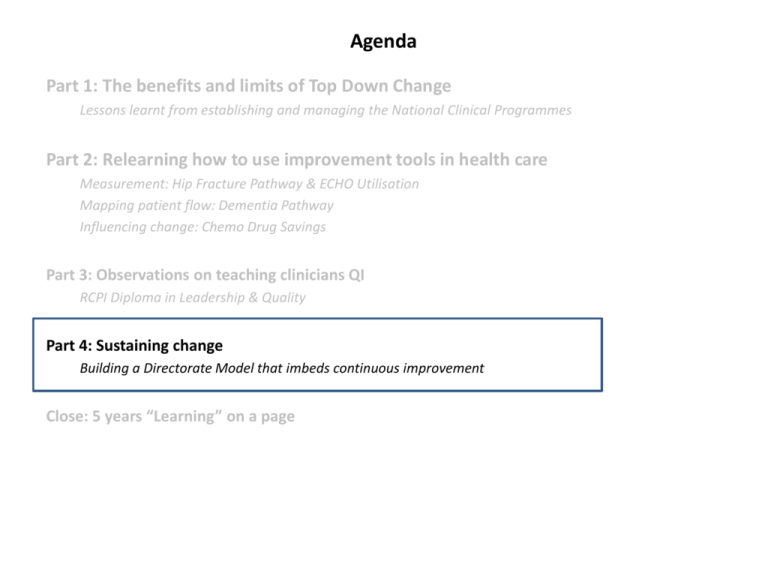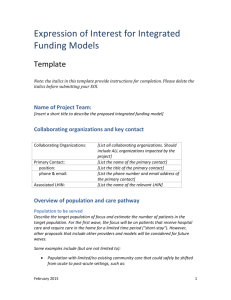Click here for information/slides at the event
advertisement

Agenda Part 1: The benefits and limits of Top Down Change Lessons learnt from establishing and managing the National Clinical Programmes Part 2: Relearning how to use improvement tools in health care Measurement: Hip Fracture Pathway & ECHO Utilisation Mapping patient flow: Dementia Pathway Influencing change: Chemo Drug Savings Part 3: Observations on teaching clinicians QI RCPI Diploma in Leadership & Quality Part 4: Sustaining change Building a Directorate Model that imbeds continuous improvement Close: 5 years “Learning” on a page I feel isolated between my peers & management I’ve got to get out of here ASAP to fix 10 things urgently. Where is the structure? Who is in charge? Who is holding who accountable? What is my role & authorit y? Clinical Director Directorate Manager Directorate Nurse Manager A clinical Directorate team? Business Manager PAMs/AHP Rep Am I a rep or a member of the team? Quality & Safety Manager HR Liaison Finance Liaison How do I get safety No.1 on the agenda? What is the rest of my role about? Patients & Families I wonder if they ever talk about my experience? How do I get them to think savings and efficiency? What’s this meeting got to do with me? I can’t help them? It was simpler when I could talk direct to the CEO! What are they up to? Speciality/Service Unit Lead V V 07/09/2014 BetterWay? 3 Same Management process: A clinically led management cycle of continuous Improvement A clinically led management cycle of Continuous Improvement Shared Values High Reliability Preoccupation with Safety (Relentless focus on avoiding patient harm) Reluctance to simplify interpretations (No subjective analysis) Sensitivity to operations (Transparent measurement of patient experience & safety) Commitment to resilience (Ability to get back up after taking an organisational knock) Deference to expertise (Everyone is free to express safety concerns irrespective of title or grade) A clinically led management cycle of Continuous Improvement Shared Mission To provide Best Care for patients, based on Patient Experience, Safety, Clinical Excellence and Innovation Patient Experience Safety Clinical Excellence Innovation – Satisfied patients and families – Zero Harm – Best Patient Outcomes – Continuous improvement Shared Aims Patient Safety Patient Access Patient Flow Patient Outcomes Patient Experience Team Research & Innovation Training & Knowledge Sharing Equitable resource allocation & waste avoidance A clinically led management cycle of Continuous Improvement Patient pathway description levels Level 1: Systems level Pathway - Shows flow between core Primary, Secondary & Tertiary Services - macro level Level 2: Directorate specific Pathway - Shows the flow of those parts of a patient pathway directly managed by a Directorate Level 3: Speciality specific Pathways - Lists the scope of services and pathways managed directly by a speciality or service Level 4: Condition specific Pathways - Shows the flow of an integrated care pathway that crosses specialities, professions & care settings micro level e.g. Hip fracture, Dementia, Epilepsy, etc. 11 End to end systems pathway (level 1) Patient Patient information web site Self Management Walk-in GP/Primary Care Team Ambulance Triage and EWS Critical Care (ICU/HDU) Emergency Department Triage and/EWS Chronic disease management Initial Assessment Acute Medical Unit (AMU) Incl.AMAU/MAU Community Pharmacy GP Diagnostic requests EWS Radiology Diagnostics Ambulatory Care (Day) Services Surgical Assessment Unit Speciality Pathology Diagnostics Diagnostics e.g. Cardiovascular Outreach Service Working Diagnosis Out Patient Clinics Elective Surgery Emergency Surgery Rapid Access Clinics OPAT Mortuary Community Intervention Team Bed management EWS Community Rehab services Discharge management Admission to wards Long term care Specialist Wards Home In Patient Palliative Care Care plan EWS Short stay unit EWS Condition Specific Services e.g. Stroke, PCI, CPAU, Epilepsy, PCI, Diabetes, Rehab, etc. EWS Hospital retrieval Transfer 2 Hospital Network Hospice Care Medical Pathway (Level MEDPatient Pathway (level 2) 2) ICU Unscheduled Care Acute Floor Surgery MedEL Home 3. CPAU 5. Specialist Assessment 4. PCI Ambulance 1. ED Assessment Walk - in GP referral Y Discharge? Demand & Capacity analysis 2. AMU Assessment Cancer N Specialist Assess ment required? Y Discharge? GP Bed demand & Capacity analysis N Admit 6. Bed N Admit Management 7. Manage inpatient care (incl. SSU) 8. Manage In Patient Discharge Intermediary care LTC Y OPD Referral Y Rapid Access Scheduled Care OPD demand & Capacity analysis GP referral 8. Plan & schedule outpatient clinics Day Care demand & Capacity analysis 10. Chronic Disease Programmes 9. Manage outpatient clinics Admission required? Other referral Discharge 13 N 11. Plan & Schedule Day Care clinics 12. Day Care Procedures Individual MED Speciality & Services pathways (level 3) Specialities • Acute/Gen Medicine/ Clinical Pharmacology • Emergency Medicine • Cardiology • Respiratory • Rheumatology • Dermatology • Endocrinology • Nephrology • Neurology/ Neurophysiology • Gastro Hepatology • GUM & ID • Psychological Medicine Clinical Measurement Cardiac Respiratory Neurophysiology Administration & Scheduling • Clerical Admin • Out patients • Data management Wards R Adams H Heuston V Synge P1H H5 Unit 2 Acute floor • AMAU (Kevin's & wilde) • Obs Ward • CPAU • John Cheyne – Trans Unit Private 1 (Shared) Private 3 (Shared) Day Care Procedure Services Endoscopy Cath. Labs Mohs Dialysis Infusions (suite) GUIDE Day Unit MDT Day Care Services Diabetes (DDC) Epilepsey GUIDE Heart Failure Hepatology Respiratory Ass. Unit 14 Rheumatology A clinically led management cycle of Continuous Improvement MED Management Structure ICU Unscheduled Care Acute Floor Surgery MedEL Home 3. CPAU 5. Specialist Assessment 4. PCI Ambulance Cancer 1. Acute Floor Y ED Assessment Walk - in GP referral Discharge? Demand & Capacity analysis 2. AMU Assessment N Specialist Assess ment required? Y Discharge? In-patient Care Bed demand & Capacity analysis N Admit 6. Bed N Admit Management 7. Manage inpatient care (incl. SSU) 8. Manage In Patient Discharge GP Intermediary care LTC Y OPD Referral Y Rapid Access OPD demand & Capacity analysis Scheduled Care GP referral 8. Plan & schedule outpatient clinics Other referral Day Care demand & Capacity analysis 10. Chronic Disease Programmes 9. Manage outpatient clinics Out patient and Chronic Disease Programmes Discharge Admission required? N 11. Plan & Schedule Day Care clinics 12. Day Care Procedures Day Procedures COO Speciality Group Leads x 12 Clinical Director DON Operations Manager Directorate Services Managers (DSM) ADONs Quality and Safety lead (ADON) Data analyst Acute Floor DSM ED AMU/SSU(AMAU) Day Services DSM Day Services Chronic Disease/Nat Clin Progs/ADON Acute floor ADON · · · · · · Inpatients ADON · · · · · · · · ED AMU (Obs ward)(8) AMAU (59) CPAU (4) John Cheyne(16) TU (10) Day Services ADON R Adams (31) John Heuston (31) Victor Synge (31) P1H (31/11Med20 Surg) H&H (14) H5/2 (28) Private 3 (30) CCU ? (10) · · · · · · · · Endoscopy Cath lab / ?CCU (10) Infusion suite (Neuro/Rheum/GI) Dialysis MOHS GUIDE day ward H&H day beds X-ray Incl all OPDs & day centres · GUM/ID (H5) · DDC (Diabetes) (H5) · H5 Dermatology (phototherapy/Mohs) (H5) · RDC (Rheumatology day care centre) · Hepatology (Hepatology centre) · Outreach – Epilpesy/COPD/Diabetes/OPAT · Heart Failure Unit · Resp Assess Unit Chronic diseases DSM Chronic Diseases/Nat Clin Progs ED/AMU flow co-ordinator (CNM II ED) OPD clinic co-ordinator with SACC (new role) Bed management/Site Management out of hours Discharge Co-ordinator with SACC (bed management function /hours of work) 17 A clinically led management cycle of Continuous Improvement MED Key Measures Month Bar Can be widened or narrowed Time axis Actual Start time 8.30 Aim Day of week List of actual start times Filter options: By Speciality, Theatre or Day of week Reasons for delay A clinically led management cycle of Continuous Improvement Operational management meeting process Meeting tracker Fixed agenda Used at all organisation levels Agenda: Directorate management team 1. Review of status of actions arising from last meeting 2. Identification of variation in key metrics Medical patients overall Avlos 12.0 11.5 • Patient Experience, safety & outcomes 11.0 10.5 10.0 • Access & Flow 9.5 • Team 8.5 9.0 8.0 7.5 • Resource & waste 7.0 6.5 • Training & research 6.0 5.5 5.0 3. Agreement on actions to address variation (JDI or QI) 4.5 5. AOB “Crisis” dealt with last not first Target overall Avlos for Medical Patients 13 13 29 /1 2 /2 0 13 22 /1 2 /2 0 13 15 /1 2 /2 0 13 /1 2 /2 0 13 /2 0 /1 2 01 08 13 24 /1 1 /2 0 13 17 /1 1 /2 0 13 10 /1 1 /2 0 13 03 /1 1 /2 0 13 27 /1 0 /2 0 13 20 /1 0 /2 0 13 13 /1 0 /2 0 13 06 /1 0 /2 0 13 29 /0 9 /2 0 13 /2 0 /0 9 /2 0 22 /0 9 /0 9 15 08 4. Review of progress of improvement projects /2 0 13 4.0 Actual overall Avlos for medical patients Objective: Organisational Alignment Shared Objectives agreed Outcome & process data circulated Speciality /Service Team Review Variation against Objectives & action Inform & discuss Directorate Inform & Management Team discuss • Access & Flow • Team • Training & Research Team Tracker COO CEO EMG • Patient experience, safety & outcomes Directorate Tracker Positive tension Board Inform & discuss National Director of Hospitals /SDU Negative tension Objective: Avoid Command & Control Patient & family Clinician/Nurse/AHP Kicking reaches here….. Mid Staff ? Pathway/Service Unit Team Directorate Management Team Senior Management Team CEO National Director of Hospitals A. Set narrow set of targets & expectations without appreciating hospitals capacity & capability to deliver change = creates fuel for the kicking B. Hold Minister to their promises Minister/Advisors/DOH Media/ Opposition C. Kicking starts here & works its way down How?: A clinically led management cycle of Continuous Improvement Agenda Part 1: The benefits and limits of Top Down Change Lessons learnt from establishing and managing the National Clinical Programmes Part 2: Relearning how to use improvement tools in health care Measurement: Hip Fracture Pathway & ECHO Utilisation Mapping patient flow: Dementia Pathway Influencing change: Chemo Drug Savings Part 3: Observations on teaching clinicians QI RCPI Diploma in Leadership & Quality Part 4: Sustaining change Building a Directorate Model that imbeds continuous improvement Close: 5 years “Learning” on a page Key lessons learnt Its about: • Clinical Leadership not involvement • Money follows the patient works – with clinical engagement • Implementing a clinically led management process that imbeds continuous improvement - its not about organisation structures and governance • Investing in producing real time data that shows both the level of variation and the reasons for it – its not about managing through anecdotes • Safety and Cost being part of the same discussion not two separate discussions • Unwinding peoples anger so that we can have more adult conversations • Developing internal coaches not training everyone in QI • Running effective, data driven , action orientated meetings not having “groundhog day "meetings • the partnership between motivating clinical leaders and professional operational managers • Focusing on Patient Safety, Outcomes and experience – if you do you will be default be improving access, flow and cost • Reducing waste and variation for moral not cost reasons • Having a shared set of aims • Celebrating success and sharing lessons from failure.






![Major Change to a Course or Pathway [DOCX 31.06KB]](http://s3.studylib.net/store/data/006879957_1-7d46b1f6b93d0bf5c854352080131369-300x300.png)